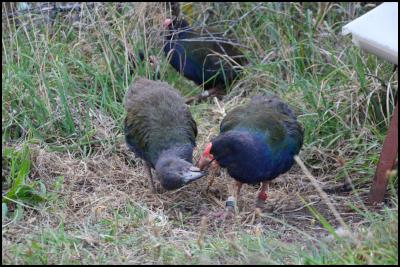Takahē chick hatched on Motutapu island

Takahe chick (left) hatched on Motuapu with father Bradshaw (right). Watched by chick's mothers Emelius & Charlie. Photo: Justine Mariette.
Tuesday March 1, 2016
Takahē chick hatched on
Motutapu island
A takahē chick has been
hatched on pest free Motutapu, a further step in
establishing the island as a key breeding site for the
critically endangered native bird.
The total takahē
population sits at 283, 20 of these adult takahē are living
on Motutapu, a half hour ferry ride from downtown
Auckland.
The first takahē were released on Motutapu on August 27, 2011, when Motutapu and Rangitoto - the islands are connected by a short bridge - were declared a pest free sanctuary.
Takahē were once widespread throughout New Zealand but have been brought to the brink of extinction by predators - particularly stoats - and the destruction of their habitat.
“We’re
thrilled to see a takahē chick hatched and faring well on
Motutapu,” says Deidre Vercoe, manager of the Department
of Conservation Takahē Recovery Group.
“This is a
tribute to our work with the Motutapu Restoration Trust,
Ngāi Tai ki Tāmaki, Ngāi Tahu and Mitre 10 to build a
breeding population of takahē on the island. This is a key
part of our programme to secure the survival of this unique
New Zealand bird.”
“We have seven breeding groups of takahē on Motutapu. All of them sat on nests this breeding season. One breeding group has hatched and is successfully raising a chick. It’s fantastic to see these special birds making the island their home,” says Motutapu Restoration Trust chair Brett Butland.
“We welcome the birth of this takahē chick on Motutapu. The island plays a vital role in the Takahē Recovery Programme. Removing stoats and other predators has created a sanctuary that’s enabling this taonga to thrive on the island,” says Ngāi Tai ki Tāmaki Tribal Trust chair, James Brown.

Takahe chick (left) hatched on Motutapu with one of its mothers Charlie & father Bradshaw. Photo Justine Mariette
Takahē usually breed as pairs but sometimes
form extended family groups to hatch and raise chicks. The
chick on Motutapu was hatched and is being raised by two
female takahē - Charlie and Emelius - and a male called
Bradshaw. Charlie and Bradshaw were hatched at DOC ’s
Burwood Takahē Centre near Te Anau. Emelius was hatched at
Maungatautari pest free sanctuary in Waikato and moved to
Burwood as a chick. Charlie, Emelius and Bradshaw were all
released on Motutapu in November 2012.
Takahē chicks are
dependent on their parents for at least a year. They’re
included in the takahē population figure when they reach a
year old. Their peak breeding age is five to 14 and they can
live up to 20 years.
Takahē begin breeding in September
and continue breeding through the summer months. The
2015/2016 breeding season produced almost 40 takahē chicks
at secure sites, a record for the Takahē Recovery
Group.
“Motutapu has good existing habitat for takahē. We’re working with the Motutapu Restoration Trust to expand this habitat so we can accommodate 20 to 25 breeding pair of takahē on the island,” says Deidre Vercoe.
“Our volunteers are planting native plants to provide the cover and food source takahē need to survive on Motutapu,” says Brett Butland.
Takahē like a semi wetlands habitat. They’re flightless, build nests on the ground from tussock and other grasses and need vegetation cover for their eggs and chicks. They eat the stems of tussock and other grasses.
Motutapu Restoration Trust volunteers have established a nursery and planted half a million native plants and trees on the island. This has provided a home for threatened native birds - takahē, Coromandel brown kiwi, shore plover/tuturuatu, tīeke/saddleback and whiteheads/pōpokotea - released on the island since it was declared pest free in 2011.
Mitre 10 has been working in partnership with DOC to
save takahē since 2005. Mitre 10 has provided more than $1
million dollars for this work through the Mitre 10 Takahē
Rescue programme. Support from this valued partnership has
been critical in the recovery of this species.
The Mitre
10 partnership has enabled DOC to:
· Purchase
incubators for hatching at the Burwood Takahē Centre near
Te Anau.
· Construct new holding pens and enclosures so chicks can grow to a size that improves their chances of survival once they are released back into the wild.
· Develop vaccination and disease risk screening programmes to prevent illness in takahē.
· Improve the monitoring and control of takahē predators particularly stoats.
· Upgrade breeding units at Burwood Takahē Centre.
· Move takahē to safe predator free islands -Motutapu, Kapiti, Maud, Mana and Tiritiri Matangi.
ends


 Gordon Campbell: On bird flu, AUKUS entry fees and Cindy Lee
Gordon Campbell: On bird flu, AUKUS entry fees and Cindy Lee Susan Botting - Local Democracy Reporter: Ruawai Leader Slams Kaipara Council In Battle Over $400k Property
Susan Botting - Local Democracy Reporter: Ruawai Leader Slams Kaipara Council In Battle Over $400k Property Te Pati Maori: Another ‘Stolen Generation’ Enabled By Court Ruling On Waitangi Tribunal Summons
Te Pati Maori: Another ‘Stolen Generation’ Enabled By Court Ruling On Waitangi Tribunal Summons Peace Action Wellington: Die In for Palestine Marks ANZAC day
Peace Action Wellington: Die In for Palestine Marks ANZAC day Labour Party: Penny Drops – But What About Seymour And Peters?
Labour Party: Penny Drops – But What About Seymour And Peters? Government: PM Announces Changes To Portfolios
Government: PM Announces Changes To Portfolios Family First: Just 1 In 6 Oppose ‘Three Strikes’ - Poll
Family First: Just 1 In 6 Oppose ‘Three Strikes’ - Poll


